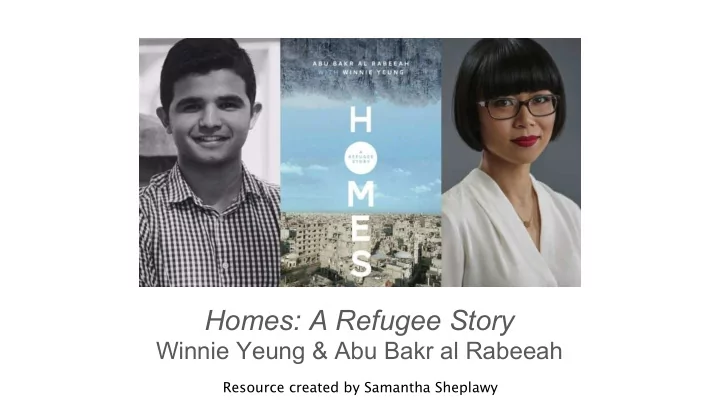

Homes: A Refugee Story Winnie Yeung & Abu Bakr al Rabeeah Resource created by Samantha Sheplawy
https://youtu.be/sWfMsD8gqWc
“It’s a story that’s both heartbreaking and hopeful, about the devastation of war and the enduring love of family — an urgently necessary read for understanding Syria and what it’s like to be a refugee.” --- Freehand Books
Iraq crisis: The Sunni-Shia divide One of the factors behind the most recent violence in Iraq is the sectarian divide between Sunni and Shia Muslims in that country. The majority of Iraq's Muslims are Shia, and the Isis militants gaining ground there are Sunni. According to the Pew Research Center, Iraq is one of only a handful of countries with a Shia majority.
Syrian Civil War https://www.youtube.com/watch?v=CoL0L_DbuQQ&feature=youtu.be
SETTING
Homs, Syria
CBC Reads 2019, 16:10 - 17:20, 44:04 - 46:18 https://youtu.be/SRxB82dKXRw
Familiar Unfamiliar/Foreign
Peace Wartime
CHARACTER
Direct or explicit characterization The author literally tells the audience what a character is like. This may be done via the narrator, another character or by the character themselves. Indirect or implicit characterization The audience must infer for themselves what the character is like through the character's thoughts, actions, speech (choice of words, manner of speaking), physical appearance, mannerisms and interaction with other characters, including other characters' reactions to that particular person.
Point of View
When studying the perspective of the narrator, the reader is Point of View concerned with the relationship between the person telling the story (the narrator) and the agents referred to by the story teller (the characters).
first-person, second-person, third-person Each term refers to a specific mode Point of View of narration defined by two things: - the distance of the narrator from the story (the pronoun case) - how much the narrator reveals about the thoughts and feelings of the characters (narrative access).
First-Person Narration The narrator is usually the protagonist or central character in the story. But even if this character is not the protagonist, he or she is Point of View directly involved in the events of the story and is telling the tale “first hand.” Telling the story from “I’s” perspective. First-person pronouns- “I, me, my, our, us, we, myself, and ourselves,”
Second-Person Narration “you” are the agent, such as in this example: you walked down the Point of View stairs. This mode of narration is not used very often in narratives and stories. More frequently, directions and instructions and usually narrated from second-person perspective.
Third-Person Narration the narrator tells the story of another person or group of people. The narrator may be far removed from or not involved in the story, or a supporting Point of View character supplying narration for a hero. “he, she, them, they, him, her, his, her, and their” used by the narrator 3 modes: objective, limited, omniscient. how much the narrator accesses the thoughts, feelings, and internal workings of the characters and shares them.
I wrestled with writing in Abu Bakr’s voice constantly. I am not a teenaged Muslim boy so writing as Voice him and taking my voice out of it was really difficult. I would Winnie Yeung scrutinize everything I wrote and ask myself, “Is this how Bakr would tell it or is this me?”
Another way I tried to make it feel more like his voice, is in how sparse some parts of the storytelling is, especially the action scenes. When Voice he talked about these events, he was so matter-of-fact. No embellishment, almost stoic. It Winnie Yeung struck me that these bombings were so melodramatic to me, because all I knew were the movies. For him, there
CBC Reads 2019, 0:05-40:26 https://youtu.be/VaqYL6-wEDA
Prejudice, Stereotypes, & Empathy
What does it Race mean to you? Ethnicity
The idea that the human species is divided into distinct groups on the basis of inherited physical and behavioral differences. Genetic studies in the late Race 20th century refuted the existence of biogenetically distinct races, and scholars now argue that “races” are cultural interventions reflecting specific attitudes and beliefs that were imposed on different populations
A category of people who identify with each other based on similarities such as Ethnicity common ancestry, language, history, society, culture or nation. Usually an inherited status based on the society in which one lives.
Overgeneralized beliefs about a particular category of people. Stereotypes Stereotypes are generalized because one assumes that the stereotype is true for each individual person in the category. Based on prejudice.
● Preconceived opinion that is not based on reason or actual Prejudice experience. ● An affective feeling towards a person or group member based solely on that person's group membership.
The unjust or prejudicial treatment Discrimination of different categories of people or things, especially on the grounds of race, age, or sex.
The capacity to understand or feel Empathy what another person is experiencing from within their frame of reference, that is, the capacity to place oneself in another's position.
CBC Reads 2019, 18:28-19:39 https://youtu.be/Ba0VftrDbfQ
Adversity, Privilege, & Coping
Adversity A state or instance of serious or continued difficulty or misfortune.
Privilege A special right, advantage, or immunity granted or available only to a particular person or group.
Adversities Coping With & Overcoming Adversity
Adversities Coping With & Overcoming Adversity What do they have in common?
A group of people living in the same place or having a particular Community characteristic in common. A feeling of fellowship with others, as a result of sharing common attitudes, interests, and goals.
What does Home Mean?
Homes: A Refugee Story
Refugee: a person who is forced to flee from persecution
Recommend
More recommend